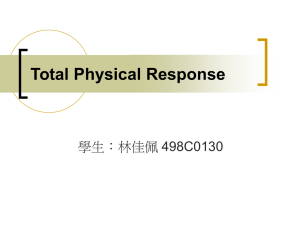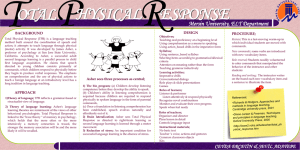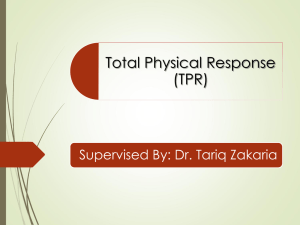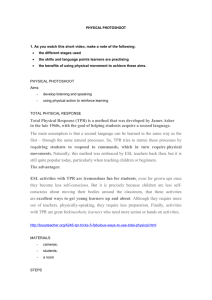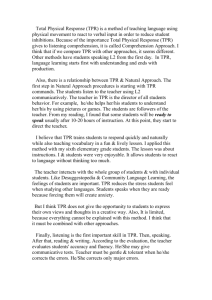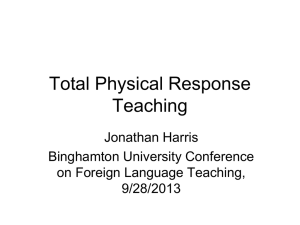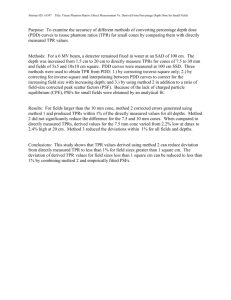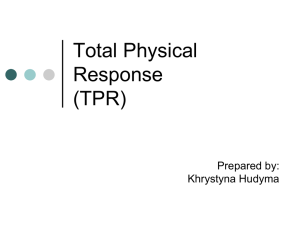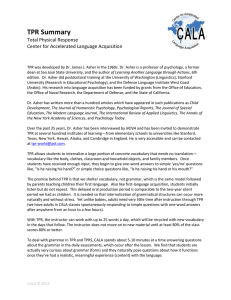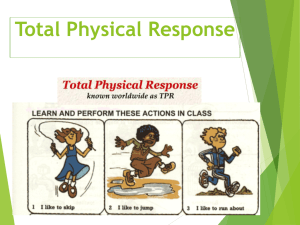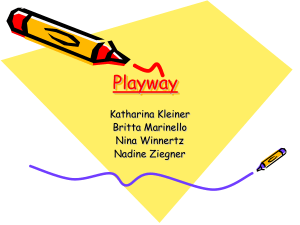File
advertisement
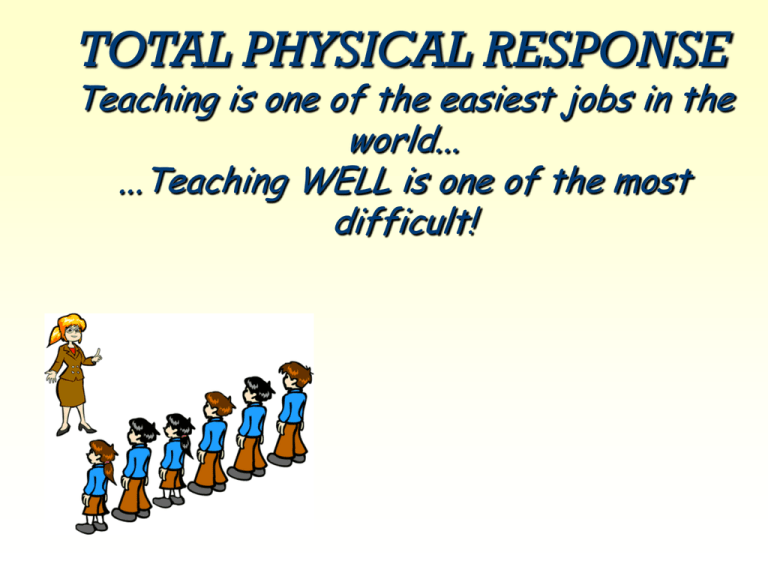
TOTAL PHYSICAL RESPONSE Teaching is one of the easiest jobs in the world... ...Teaching WELL is one of the most difficult! TPR (TOTAL PHYSICAL RESPONSE) TPR is a method in language teaching which is based on the coordination of speech and action. It allows students to react to language without thinking too much. The students are required to carry out the instructions by physically performing the activities. TPR was developed by James Asher, who is a professor of psychology at San Jose State University in California. What is the aim of this method? The aim is to teach language via physical(motor) activity. *Asher also pays attention to; Language teaching procedures + Developmental psychology Learning theory Humanistic pedagogy James Asher thinks that; * Second language learning is parallel to first language learning. * Both of them have parallel processes. * Speech ► Commands * Commands ► Physical response * Physical response ► Verbal response **Gamelike movements and understandable linguistic production; ► reduce stress. ► create a positive mood in the learner. ► facilitate learning. ♦ Theory of language → A grammar based view of language → Verb ► In ımperative form ♦ Theory of language learning → A stimulus-response view “TRACE THEORY” Trace theory * More often or intensive memory connection ▼ * Stronger memory association ▼ * More likely it will be recalled Three hypotheses that Asher suggests; *Bio-program *Brain Lateralization *Reduction of stress The bio-program * Innate * First listening competence and then the ability to speak * Listening comprehension ► To respond physically to spoken language * Establishment of listening comprehension ► Speech evolves naturally and effortlessly. . Listening=> Accompanied by physical movement . Speech and other productive skills . Sequence= Listening before speaking . Mode= To synchronize language with the individual’s body. Brain Lateralization * Jean Piaget * Asher says that TPR is directed to right brain learning while most second language teaching theories are directed to left brain learning. * Right-left-brain learning (different learning functions) - Right-brain activity ► Motor movement - Left-brain activity ► Watching and learning Reduction of Stress Absence of stress ►An important condition for successful language learning • Asher; ** Language acquisition: In a stress-free environment ** Adult language learning environment: Stress and anxiety . The lower the stress, the greater the learning. • ☼ The keys to stress-free learning: ► Using natural bio-program. ► Remembering relaxed and enjoyable experiences. ► Focusing on meaning. ► Getting away from self-conscious and stressful situations. ► Devoting full energy to learning. ► Not forcing student to speak * Objectives * Syllabus * Learning activities * Roles of learner * Roles of teacher * Materials OBJECTIVES ♣ Using action-based drills in the imperative form. ♣ Teaching oral proficiency at a beginning level. ♣ Teaching basic speaking skills. ♣ Using comprehension as a means to speaking. ♣ Facilitating a suitable “comprehension” and “speaking” period. SYLLABUS * Seeing the rules in context (inductively). * Using sentence-based grammatical syllabus. * Paying attention to meaning rather than the form and text * TPR works best with about 8 students. * A fixed number of items ( Assimilating 12 to 36 new lexical İtems) Learning Activities ► Using objects ► Role plays and slide presentations ► Story telling ► Games ► Imperative exercises Roles of learners * Primary roles : Listener and performer * Listening attentively * Responding physically To commands given by the teacher * Recognizing and responding to new combinations of previously taught items * Producing new combinations on their own * Monitoring and evaluating their own progress * Being encouraged to speak *Speaking when become ready Roles of Teachers * An active and direct role in TPR * Decider * Director * Organizer * Detailed lesson plan creator * OPPORTUNITY PROVIDER * Feedback giver * A sensitive instructor to the STUDENTS ● No basic text ● For beginners; - Teacher’s voice - Actions - Gestures ● After a period of learning - Books, pens, cup, furniture ● In later learning stages; - Materials( pictures, word charts etc.) - Realia ● Kits ☺ Review ►A fast-moving warm up ☺ New commands ☺ Asking simple questions ☺ Role reversal ☺ Reading and writing * Enjoyable and easy for teachers as well as students * Long-term retention (recollection-keep in mind) * Immediate comprehension of the target language * Stress-free * Facilitator in language learning * A helpful alternative teaching strategy * Only suitable for beginner level * A challenge for shy students * Avoiding students from expressing their own ideas * Insufficient to teach abstract language CONCLUSION TOTAL PHYSICAL RESPONSE * Physical response to the commands is important. * Physical reaction is given priority; speech occurs when the learner is ready. * Reviewing, giving new commands, asking simple questions, role reversal, reading and writing are the types of learning activities. * Pictures, word charts, kits etc. are used during the learning stage. * Right-brain acitivities (physical/motor acitivities) have a primary role on learning. * Syllabus is sentence-based. AUDIOLINGUAL * Active verbal interaction is given importance. * The focus is on immediate and accurate speech. * Reflection, restatement, contarction, replacement etc. are types of learning. * Tape recorders and audiovisual equipment are the instructional materials for this method. * Structure, grammar points and rules are also important. * Syllabus is structure-based and includes the key items of phonology, morphology and syntax. SIMILARITIES BETWEEN AUDIOLINGUAL AND TOTAL PHYSICAL RESPONSE * Both of them give importance to speaking skills before reading and writing. * Teachers are active and central. * Drills are important for both of them. * Teaching of the grammar is inductive. * Classes of ten or fewer are considered optimal. REFERENCES * Richards,C. Jack & Rodgers,S.Theodore (2002) Cambridge University Press Approaches and Methods in Language Teaching *http://www.sil.org/LinguaLinks/LanguageLearning/WaysToApproachLangu ageLearning/TotalPhysicalResponse.htm * http://www.teacherjoe.us/TeachersTPR.html * http://www.onestopenglish.com/section.asp?docid=146503 * http://coe.sdsu.edu/people/jmora/almmethods.htm#TPR * http://www.c-english.com/files/tpr.pdf *http://209.85.135.132/search?q=cache:G1lF__GfxQ4J:www.springinstitu te.org/Files/tpr4.pdf+total+physical+response&cd=17&hl=tr&ct=clnk&gl =tr * http://www.teachingenglish.org.uk/think/articles/total-physicalresponse-tpr * http://conference.nie.edu.sg/paper/new%20converted/ab00466.pdf * http://wiki.galbijim.com/Total_Physical_Response#Disadvantages * http://www.foreignlanguagesweb.com/teaching/methods/tpr.htm
